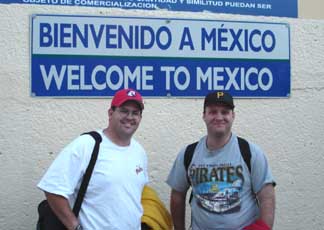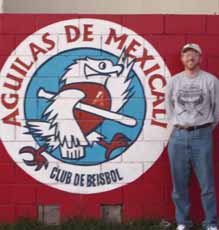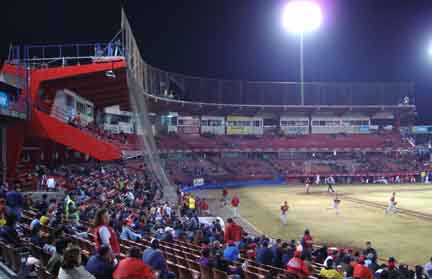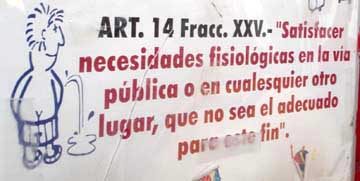Article and all photos by Joe Mock, BaseballParks.com
All rights reserved
When I attended several Arizona Fall League games in October of 2004, I figured my ballpark adventures were over for the year. I had racked up a healthy 51 parks, so I was quite satisfied with my accomplishments for the year.
But when I found myself along the California-Mexico border in December, I grabbed the chance to experience something completely new to me: baseball south of the border. While the regular Mexican League plays during the same part of the year as baseball in the U.S., Mexico also has a winter league. The Mexican Pacific League plays in different cities than its summertime counterpart, and since its season is the “offseason” in the U.S., quite a few American players compete.
Mexicali is a “border town” that sits along the border with California. It is just across from Calexico, CA, which is about 100 miles east of San Diego. Its baseball team is, in English, the Eagles — but it’s more fun to say the team is Los Aguilas de Mexicali.
  |
| My traveling companions for this excursion were Brian (left) and Ty, both of whom live in the San Diego area. I’m in the photo on the right. |
Of the Mexican border towns that have baseball (at various times, this has included Tijuana, Juarez and Laredo), Mexicali is probably the best choice to experience your first Mexican “beisbol.” First, the border crossing isn’t the madhouse that it can be in Tijuana or Juarez. Second, Mexicali is probably one of the nicest of the “border towns,” meaning it isn’t quite as seedy. Third, getting to the city’s ballpark isn’t difficult. And fourth, the atmosphere at the park is quite friendly, because there are plenty of employees at the souvenir and concession stands who speak English, and U.S. dollars are readily accepted.
By chance, I was able to link up with two veterans of crossing the border into Mexicali. I had been contacted by Brian of San Diego not long before my trip to California. He e-mailed me to request the ballpark scoresheet that I offer for free through this site. When he reported that he had seen quite a few games in Mexicali, I told him that I was going to be in California and that I was curious what it was like going to a game there. He offered to meet me and take me with him to a game. What a great guy!
He brought his friend Ty, and the three of us set out for a south-of-the-border adventure. Their tried-and-true approach to this is to park on the U.S. side of the border (in Calexico), and then walk across the border. There, we would catch a taxi to the ballpark (it cost about $5). Since taxis weren’t as easy to find after a game, they knew the bus routes, and we caught a bus (cost: about 55 cents) right back to the crossing point.
And the plan worked perfectly. We were able to avoid the hassle of trying to drive across the border, and the transportation costs were minimal.
I was shocked at how ridiculously easy it is to enter Mexico. No one asked to see a passport or ID. No one checked what we were bringing into the country. In fact, there were no Mexican officials present when we walked through the large iron gates into Mexicali. By the way, when we walked back across the border at the end of the evening, it was no hassle at all. The U.S. officials examined our photo IDs (we used drivers licenses), asked what we had done in Mexico, and asked us where we were born. That was it. No long lines, no search of our belongings, no big interrogation. Going both ways was pretty painless.
Taking a taxi to the ballpark was quite efficient. He dropped us off at the ticket window, which was great.
 |
| This is the courtyard area where food and souvenirs can be found. The extreme left-hand area of this shot shows the ramp that leads you to the rear of the main seating bowl. |
The park itself is called “Nido de los Aguilas,” which means the Eagles’ Nest. The tickets were incredibly inexpensive. The best seats in the house, theater-type seats right behind home plate, were about $4. In fact, everything was astonishingly cheap. Delicious tacos were about a buck. Team merchandise was so inexpensive that I really loaded up (I figured the souvenirs would make great Christmas gifts!). For instance, I purchased an authentic team jersey for about $26. I bet at Major League parks in the U.S., such a jersey would fetch about $100.
In addition to the tacos, I also had an order of “Bubbas” (which they pronounce “BOO-bus”). For $4, I received a large portion of grilled sausage, diced to be bite-size. Delicious!
A word of warning about eating and drinking in Mexico: only eat what you’ve seen cooked in front of you, and only drink from sealed bottles. The digestive system of Mexicans can tolerate a lot of bacteria that we delicate Americans can’t. If you don’t want a nasty bout of “Montezuma’s revenge” later that night, then absolutely do not eat items like vegetables, guacamole, or dishes prepared somewhere other than before your eyes. Also, you are crazy if you drink from a water fountain.
And another suggestion: take a little bottle of anti-bacterial hand-wash with you. If you use the restroom, you’ll be better off cleaning your hands with that than the water from the faucets.
I’m happy to report that I made it through unscathed (i.e., no digestive problems). I think this is the case because I was very, very careful about what I ate while in Mexicali.
 |
| Here you see the double-decked grandstand behind home plate. Note the large backstop that runs from the ground up to the overhang. |
The ballpark itself was very interesting. The exterior was fairly junky and unkempt. Maintenance and landscaping are foreign notions at ballparks like this. This doesn’t mean that it was ugly or that it was an objectionable place to watch a game. Far from it, as I enjoyed my time at this park immensely.
It appears that the original structure was a double-decked grandstand directly behind homeplate that was constructed in 1986. The backstop is a huge screen that runs to the front of the overhang above the upper deck, meaning foul balls cannot reach these seats. Down both lines are large concrete structures offering several thousand more seats. It appears obvious that these sections were built long after the original grandstand.
The newer seating sections certainly provide a good view of the field, although two oddities jumped out at me. First, there is a large section of seats behind first base that were cordoned off. By the look of the plastic seats themselves, I would say that it wasn’t safe to sit here, as the bent and broken seats looked like they’d gotten in the way of an elephant herd. Second, it appears that these sections weren’t completely finished, as there is concrete near the foul poles, but no seats were actually installed there.
There is no “grassy berm” beyond the outfield fences, just rickety-looking scoffolding holding up planks on which patrons could sit. This outfield area is the general admission area.
These bleachers, if you can call them that, are between the outfield wall and the immense advertising signs that run foul pole to foul pole. I think this was the tallest outfield signage I’ve ever seen at a ballpark.
The playing field was, at best, sub-par. The grass was anything but green, and the infield dirt didn’t provide the best bounces.
There is no such thing as an “open councourse” at Nido de los Aguilas, at least not in the way that phrase is applied to U.S. ballparks these days. The concourse itself was extremely “open,” though. In fact, it was all the way behind the main grandstand, forming a courtyard of sorts where the various food vendors and souvenir stands were located. There were two large projection screens showing a broadcast of a soccer game, and this did attract a lot of attention.
 |
| In this shot, you can see that the grass is anything but green. Also, note the concrete sections near the foul pole (toward the right in the photo). The concrete foundation is there, but no seats. |
The experience of attending a game here, though, was nothing short of magical — and this was mostly because of the fans, not the players. They hooted. They hollered. They chanted. It was very entertaining.
The customs of the fans are worth the price of admission. For instance, in America, fans often clap and cheer when the home-team pitcher gets two strikes on a batter. Here in Mexicali, though, the fans chant “bola, bola” when the opposing pitcher is one ball away from walking the batter. Hey, I guess it’s true that a walk is as good as a hit!
There are quite a few American minor leaguers on the rosters in the Mexican Pacific League, as this where a lot of them come to play winter ball. I’d seen or heard of a number of players on the two teams, which made watching the game even more enjoyable. The most famous name on the Mexicali roster is former Cy Young winner Fernando Valenzuela, although the 44-year-old did not appear in the game I attended. By the way, when he is scheduled to pitch, the ballpark gets quite full.
There were two mascots running around the playing field, both dressed as eagles. One is named Lucho, and the other (not to be outdone) is Super Lucho. The fans seemed to enjoy them immensely.
Of course, “Take Me Out To The Ballgame” is sung in Spanish, but it’s done after the 7th inning, not in the middle of the inning like in the U.S.
A local cell-phone company sponsors a troupe of flag-waving young ladies to help keep the crowd in the game. The fans seemed to enjoy these lovely lasses a great deal.
  |
| It’s not every day you see a sign like this at a ballpark. On the right are the flag girls. |
Finally, the most unusual sign I saw at this ballpark is shown in the picture above. This sign stands near the entry gate, and loosely translated, it says “Don’t urinate in the street or anywhere else in public.”
All in all, I had a tremendous time during my first south-of-the-border baseball game. The park was interesting and the fans were a blast to watch. And the caliber of baseball played was very good. I can’t wait to attend another game in Mexico someday! Again, thanks to Brian and Ty for letting me tag along with them. It was extremely helpful to go with folks who had made this excursion before.
If you google photos of B’Air Stadium you will see instances where the field is greener and not that bad looking (but still far from beautiful). You must have gone there during a drought. I know California gets very little rain, so I’m assuming it’s the same for northern Baja California.